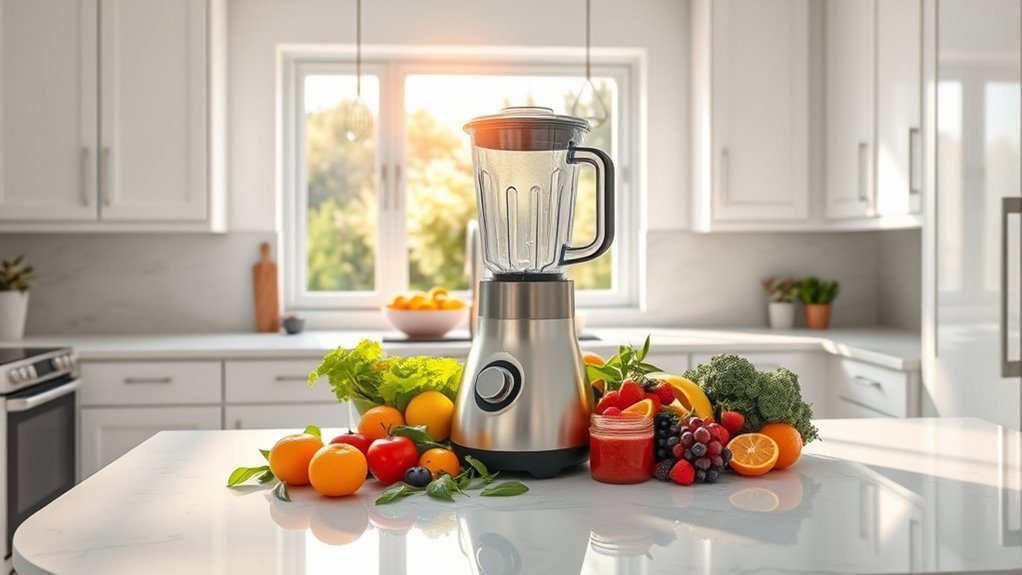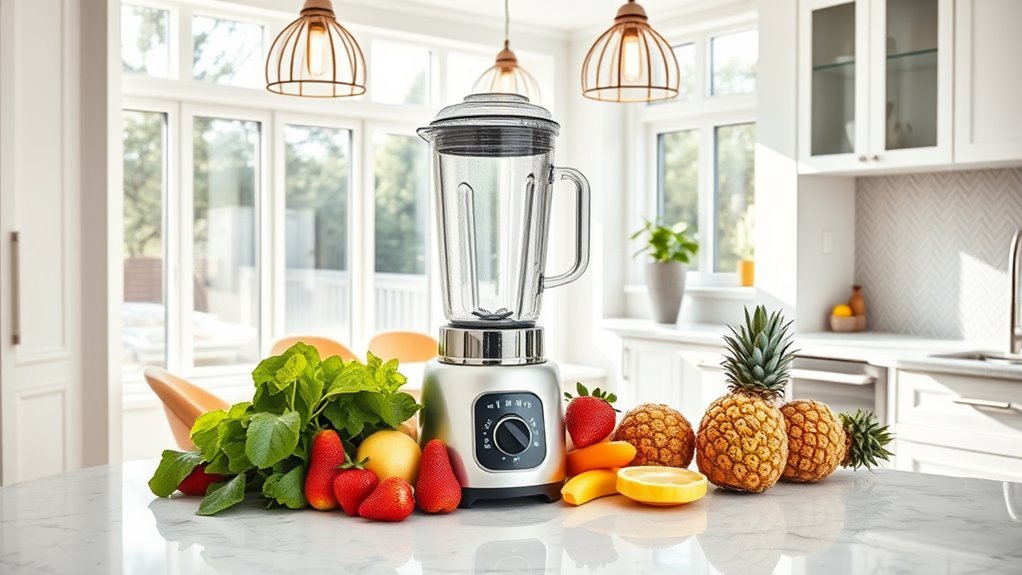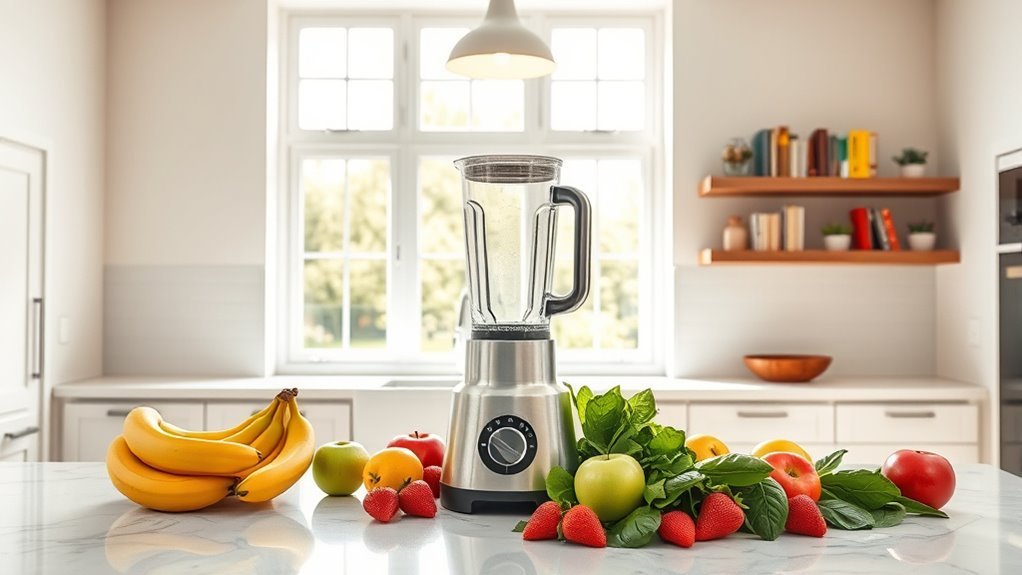We’ll help you tame those roaring blender decibels with seven proven tactics: choose models under 80 dB, position units away from walls, use rubber mats for vibration control, consider motor wattage impact, employ acoustic foam barriers, leverage sound-dampening placement strategies, and time blending during appropriate hours. While typical blenders hit 90-100 dB, smart choices like the Vitamix Quiet One operate at just 66 dB – and that’s just the beginning of your noise-reduction journey.
Understanding Blender Sound Measurement

When we’re measuring blender noise, we’ve got to tackle decibels head-on. Those numbers tell us exactly how loud our kitchen companion really is – from whisper-quiet models under 80 dB to ear-splitting monsters hitting 100 dB.
Let’s put that in perspective: your average chat runs about 68 dB, while those commercial machines are screaming motorcycle-level chaos.
Here’s what you need to know: Blender sound levels vary dramatically. Sure, that high-performance unit might pulverize anything, but at what cost to your eardrums? High-performance blenders can produce smoother textures while being quieter than many traditional models.
Smart manufacturers are catching on, though. Take the latest noise reduction tech in commercial units – they’re getting blender sound down to 66 dB. That’s quieter than your coffee shop conversation.
When hunting for a quiet blender, remember: context matters. Consider when you’ll blend and who might be sleeping nearby.
Common Household Blender Noise Ranges
The thunderous roar of household blenders spans a dramatic range from whisper-quiet to ear-splitting.
We’re looking at noise levels between 60 and 100 decibels – that’s the difference between a normal conversation and a motorcycle.
Let’s get specific: If you’re noise-conscious, aim for blenders in the 60-80 decibel range.
The BlendJet 2 hits a sweet spot at 68 decibels, barely louder than chatting with friends.
For the ultra-quiet crowd, the Vitamix Quiet One commercial model purrs at 66 decibels.
Even the Nutribullet Flip Insulated keeps things civilized at 71-73 decibels.
Want to wake the neighbors? High-performance models blast away at 90-100 decibels.
But we’ll bet your morning smoothie doesn’t need to rival a lawnmower’s roar. Choosing a blender with lower noise levels can enhance your cooking experience without disturbing others.
Impact of Motor Power on Noise Generation

Power and noise levels dance an intimate tango in blender performance.
We’ve found that motors exceeding 1,000 watts pack serious crushing power but come with a sonic price tag – they’ll blast your kitchen with 90-100 decibels, matching the roar of your neighbor’s motorcycle.
Here’s the twist: you don’t have to sacrifice your eardrums for smooth smoothies. Modern quiet blender technology, like the Vitamix Quiet One, proves we can have both – crushing power at 2237 watts while keeping noise to a civilized 66 decibels.
But let’s be real – if you’re blending at full throttle above 85 decibels, you’re gambling with your hearing.
For pre-dawn protein shakes, consider lower-powered options like the Nutribullet Flip, which keeps the noise between 71-73 decibels.
Soundproofing Materials and Their Effectiveness
Because sound waves bounce mercilessly off hard surfaces, we’ve got to fight back with strategic soundproofing. Let’s explore proven materials that reduce the noise and create a more peaceful kitchen environment.
| Material Type | Noise Reduction Effect |
|---|---|
| Acoustic Foam | High absorption, pro-grade results |
| Rubber Mats | Excellent vibration dampening |
| DIY Enclosures | Significant containment, budget-friendly |
| Heavy Fabrics | Moderate absorption, readily available |
Creating a sound enclosure doesn’t require complex engineering. We’re talking simple solutions: slip a rubber mat under your blender, surround it with acoustic foam panels, or craft a ventilated box from everyday materials. For maximum impact, combine multiple soundproofing materials. That noisy blender’s about to meet its match.
Strategic Placement for Minimal Sound Impact

Now that we’ve got our soundproofing arsenal ready, let’s tackle smart positioning – your next weapon against blender noise.
Strategic placement makes a dramatic difference in noise reduction. Position your blender at least two inches from walls to prevent sound reflection, and keep it on the counter’s far edge where noise can dissipate freely.
Don’t trap your blender in corners or enclosed spaces – that’s where sound amplification becomes your enemy.
We’ve found that combining smart placement with a sound-dampening mat or thick towel underneath creates the quietest blending experience.
For bonus points, operate your blender in rooms with soft furnishings – they’ll absorb excess noise like a charm.
Time-Based Noise Management Solutions
Three critical windows exist for managing blender noise throughout your day.
Mid-morning and early afternoon offer prime blending opportunities when household members are typically awake and active. We’ve found these times minimize disruption while maintaining your smoothie schedule.
For those early morning protein shakes, we’ll need stealth mode.
Place your blender on a sound-dampening towel and consider using a noise enclosure – your sleeping family will thank you.
If you’re stuck blending during peak hours, don’t forget ear protection.
Here’s a pro tip: Break your blending into smaller batches.
It’s quieter and more efficient, especially during those quiet hours.
With modern blenders ranging from 60-100 decibels, smart timing is your secret weapon for peaceful blending.
Choosing Low-Decibel Blender Models
While decibel ratings don’t tell the whole story, they’ll make or break your blending experience. We recommend targeting models that operate under 80 decibels – about as loud as normal conversation.
Let’s cut to the chase with top performers.
The Nutribullet Flip Insulated lands at 71-73 decibels – impressively quiet for its power. Want whisper-quiet commercial grade? Vitamix The Quiet One lives up to its name at 66 decibels.
For families, we’re fans of the Zwilling Enfinigy’s variable speeds and noise control. The Breville Super Q deserves mention for crushing ice without waking the neighbors, thanks to its clever fan cooling system.
Each of these low-decibel blender options delivers serious noise reduction without sacrificing performance. Trust us – your ears will thank you.
Frequently Asked Questions
How to Reduce the Noise of a Blender?
Let’s reduce our blender’s noise using proven soundproofing techniques: place it on dampening materials, keep it from walls, blend smaller batches, and use a sound enclosure for quieter operation.
Which Blender Is Most Quiet?
We’d think all blenders roar like lions, but Vitamix The Quiet One proves otherwise at just 66 decibels. Its silent blender features and noise-reduction shield make it our top quiet blender brand.
Can Neighbors Hear a Blender?
Yes, neighbors can hear our blenders, especially in shared living spaces. We’ll minimize disturbance by using blender soundproofing techniques, practicing neighborly noise etiquette, and choosing appropriate blender usage timing.
How Loud Should a Blender Be?
We’d expect typical blender sound levels to range from 70-90 decibels, though quieter models can operate under 80 decibels. In blender noise comparison tests, anything above 90 decibels is considered unusually loud.
What Is the Optimal Noise Threshold in Blender?
We’ve found that blenders should stay between 60-80 decibels for ideal noise levels. If you’re concerned about sound, consider blender soundproofing techniques or invest in quiet brands like Vitamix or Nutribullet.

